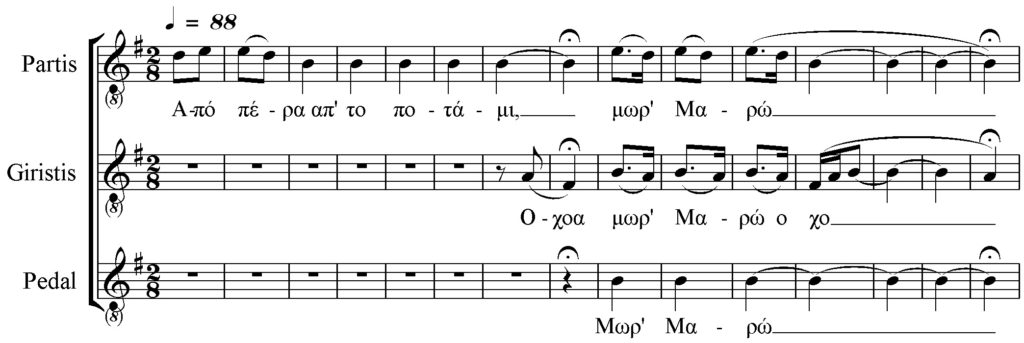Greek Choral Folk Song
Lora Petropoulou
soprano & choral conductor
Folk song in Greece, deriving from Ancient Greek Music[1] and the Byzantine music which followed, is primarily monophonic, with an instrumental accompaniment which was based on the doubling and embellishing of the melody and the existence of a pedal. Since the first half of the 19th century, when the Bavarians came to Greece, three-note chords have been added to the accompaniment.
Two areas of western Greece are exceptions to this: Epirus and the Ionian islands, where both homophonic and polyphonic forms thrived as an expression of people’s feelings.
The polyphonic song of Epirus
As is the case with all mountainous areas and with places detached from urban centers, in Epirus the archetype pentatonic scale survives, and is the base for the main musical idiom[2]. The absence of the strong dissonance of the interval of minor second makes this system convenient for polyphonic use.
The melodies of the polyphonic songs of Epirus are simple and the rhythm is either regular, using two or three beats per bar, or irregular (five or seven beats); however, rhythms are quite often interchangeable within the same song.
The songs of Epirus are polyphonic, mainly without instrumental accompaniment, and number of voices varies from two to four. Musical instruments were introduced only later. Their performance requires the presence of a group where each member has a distinctive role. This group consists of between four and 15 singers[3]. One important characteristic of the polyphonic song is the presence of three or four independent melodic lines[4]:
- The partis is the leading singer who sings the main melody and at the same time leads, coordinates and organizes the group.
- The gyristis or klostis sings contrapuntally[5] the second melodic line. His presence is crucial for the style, always leading to a dissonance with the partis (a major second or a minor seventh).
- The rihtis was added during the 20th century and sings a third melodic line.
- The pedal keepers are a group of choristers who hold the tonic note.
A video clip is found here: http://www.youtube.com/watch?v=2zH8_a1dP6g&feature=related
The chorus song of the Eptanisos
Eptanisos is the name of the cluster of seven islands located in the Ionian Sea which separates Greece from Italy. The biggest of these islands are Cephalonia, Corfu, Zante and Lefkada. The combination of Italian influence and Greek Byzantine tradition, enriched by the culture of the inhabitants of the Eptanisos, brought about the creation of a kind of homophonic folk song that is entirely different from the folk songs of the rest of Greece. Thus, during the 17th century, in Lixouri, the most important administration center of Cephalonia, the arietta (a small aria) appeared. This is a two or four-versed song, sung in two repeats, and always conceived in a major mode, this being more suitable for improvisations than the minor one.
The kantada (from the Italian word canto) derives from the arietta. One of the principal characteristics distinguishing the arietta from the kantada, is that the main melody of the former was sung solo by a tenor; then, at one point of the phrase or just before the cadence, the other voices would enter and harmonically support him. The song was eventually developed phrase to phrase up to its end. Correspondingly, in the kantada every voice was sung by a group of singers, whereas solo voices were rare.

Both the arietta and the kantada[6] are attractive, melodic songs for a male voice choir, and are mainly a tribute to the beauty of life and love. Quite often young men would stand under their beloved one’s window and sing for their love. Originally, these were three-part songs without instrumental accompaniment. However, after the intervention of educated musicians, they developed into four-part songs and began to be accompanied by guitars and mandolins.
Their first creator was the unknown, everyday laborer, without any other musical skill than his own instinct and passion.Both kinds harmonically consist of:
- The primo (tenor I) – the main melodic line.
- The secondo (tenor II) who doubled the primo in parallel thirds below or sixths above.
- The terzo (bass I or baritone) was later added by educated musicians, between the tenor II and the bass, changing thus the three-part harmony into four parts. The line was based on the dominant of the scale.
- The bass II held the roots of the I-IV-V chords, connecting them with their passing notes.
A video clip is found here: http://www.youtube.com/watch?v=j1D5o9b-Dj4&feature=related
Both the arietta and the kantada travelled from Cephalonia to all the other Ionian islands, and also to Athens. On each island the music adopted the local character, so one could hear the same song sung in three different ways. In Zante arietta was changed into arekia (from ‘a orecchio’: by ear). The idiom of the kantada has passed into church music, as a natural effect of the fact that many kantada singers were also church cantors. Thus, original chants or authentic Byzantine chants were transformed into three or four-voiced compositions for a male voice choir. Both the songs of Epirus and of the Eptanisos use the same process of construction and performance.
As with folk music, these songs were created by popular artists who were not educated in either reading or writing musical scores. Therefore, the scoring of these songs would have been both impossible and pointless. To overcome this deficiency, the popular creators used their only tool: the technique of stereotypical structural elements.
In the polyphonic songs of Epirus these are:
- the melodic schemes of the klostis and
- maintaining the pedal.
(Click on the image to download the full score)
In the homophonic songs of the Eptanisos these are:
- the doubling of the primo by the secondo a third lower and
- the melodic patterns of the bass.
(Click on the image to download the full score)
For both idioms, one basic prerequisite is the security and the facilitations for improvisation provided by the material employed: the pentatonic scale and the major mode.
[1] Our folk dance “Kalamatianos”, is the Dactylic Hexameter of the Homeric epics.
[2] Ioannidis G.: Musici, Editione Mea, Athens, 1978.
[3] Lavdas A.: Pentafthoges klimakes en ti Dimodi Mousiki tis Ipirou, Ipirotiki Estia, 1957
[4] Lolis K.: To Ipirotiko polyphoniko tragoudi, Ioannina, 2006
[5] Actually this is not the real polyphony of the European Musical System, but a quasi-polyphony consisting of the use of stereotypical melodic patterns under the main melodic line (gyristis) or their transportation to an octave higher (klostis).
[6] Skiadaresis S.,: ‘Arietta kai kantada’, Ios magazine, vol.58-60, 1962.
 Lora Petropoulou, soprano and choral conductor, Member of the Board of the Pan-Hellenic Association of Conductors of Choral & Instrumental Ensembles
Lora Petropoulou, soprano and choral conductor, Member of the Board of the Pan-Hellenic Association of Conductors of Choral & Instrumental Ensembles
Edited by Giorgio Galassi, Italy

